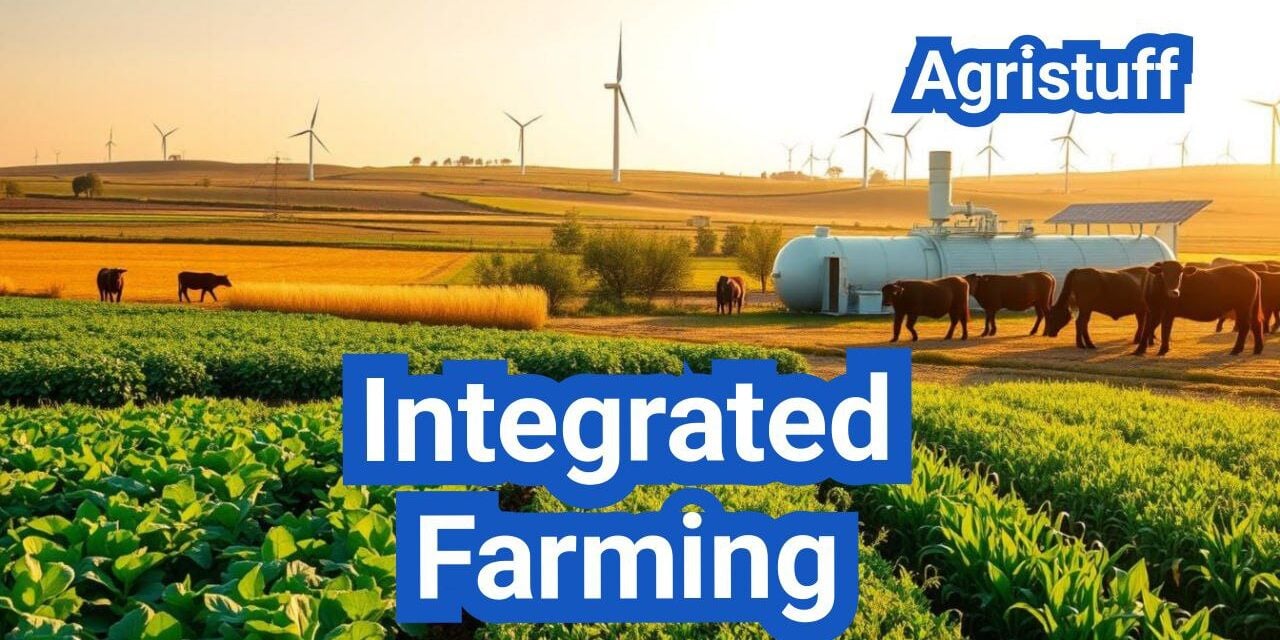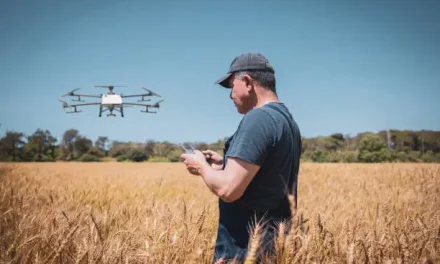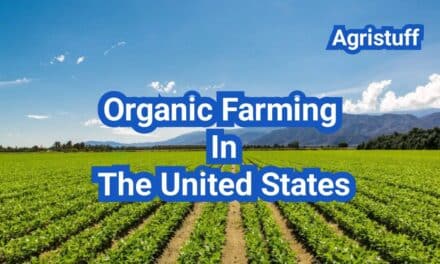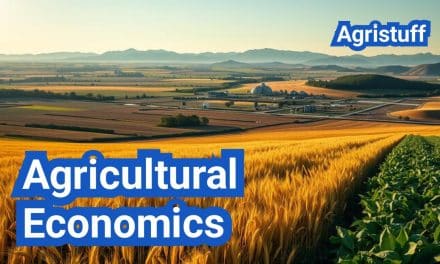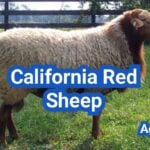The concept of integrated farming systems is revolutionizing the way we approach agriculture. By combining livestock, crops, and energy production, farmers can create a more diverse and resilient farming operation.
This holistic approach to farming not only enhances profitability but also promotes sustainable agriculture by improving soil health, biodiversity, and efficient water use. Techniques such as regenerative grazing and agroforestry practices are being adopted to achieve these benefits.
According to the Integrated Farm System Model Reference Manual, integrated farming systems offer a comprehensive framework for farmers to optimize their operations. By stacking different enterprises, farmers can improve their overall profitability and contribute to a more sustainable food system.
Key Takeaways
- Integrated farming systems combine livestock, crops, and energy for enhanced profitability.
- Sustainable agriculture practices improve soil health and biodiversity.
- Regenerative grazing and agroforestry are key techniques in integrated farming.
- The Integrated Farm System Model provides a framework for optimizing farm operations.
- Diverse farming operations can lead to a more resilient agricultural sector.
What Is an Integrated Farming System?
At its core, an Integrated Farming System is an agricultural practice that seeks to maximize efficiency and minimize waste by integrating different farming enterprises. This approach combines crops, livestock, and sometimes energy production to create a more diverse and resilient farming operation.
Integrated Farming Systems are designed to promote ecological interactions and synergies between different components of the farm. By doing so, they enhance overall productivity and reduce the environmental impact of farming activities.
Definition and Core Principles
An Integrated Farming System is characterized by the integration of multiple farming practices on a single farm. The core principles include:
- Diversification of farm products and income streams
- Efficient use of resources and minimization of waste
- Promotion of ecological balance and biodiversity
- Integration of crops and livestock to enhance productivity
The core principle of integrating different farming practices is to create a more sustainable and productive agricultural system. This is achieved through the efficient cycling of resources and the minimization of external inputs.
Historical Development in American Agriculture
The concept of Integrated Farming Systems has its roots in traditional farming practices where farmers used to integrate various agricultural activities. In American agriculture, the historical development of Integrated Farming Systems can be traced back to the early 20th century when farmers began to adopt more diversified farming practices.
The table below highlights key milestones in the evolution of Integrated Farming Systems in the USA:
| Year | Milestone | Description |
|---|---|---|
| 1930s | Soil Conservation Initiatives | Programs aimed at reducing soil erosion and promoting sustainable farming practices |
| 1970s | Organic Farming Movement | A growing interest in organic farming methods and reduced chemical use |
| 2000s | Integration of Renewable Energy | Incorporation of renewable energy sources, such as solar and wind power, into farming operations |
The historical development of Integrated Farming Systems in American agriculture reflects a continuous effort to improve sustainability and productivity. By understanding this evolution, farmers and policymakers can better appreciate the value of integrated approaches to farming.
The Economic Case for Integrated Farming

The economic case for integrated farming is built on the principles of resource cycling, diversification, and efficient energy use. This approach to farming not only enhances profitability but also contributes to a more sustainable agricultural system.
Profit Maximization Through Resource Cycling
Integrated farming systems maximize profits by cycling resources efficiently across different components of the farm. For example, crop residues can be used as feed for livestock, while manure from livestock can be used as fertilizer for crops. This closed-loop system reduces the need for external inputs, thereby lowering costs and increasing overall farm productivity.
Key benefits of resource cycling include:
- Reduced input costs through the reuse of on-farm resources
- Increased crop yields due to improved soil fertility
- Enhanced livestock health through diversified feed sources
Risk Mitigation Through Diversification
Diversification is a core principle of integrated farming, allowing farmers to spread risk across multiple enterprises. By producing a variety of crops, raising different types of livestock, and potentially generating energy, farmers can reduce their dependence on a single revenue stream. This diversification helps mitigate risks associated with market fluctuations, climate change, and other external factors.
Examples of diversification in integrated farming include:
- Crop rotation and intercropping to improve soil health and reduce pests and diseases
- Integrating livestock grazing into crop production systems
- Producing renewable energy through solar panels or biogas digesters
Return on Investment Analysis
When evaluating the economic viability of integrated farming systems, it’s crucial to conduct a thorough return on investment (ROI) analysis. This involves assessing both the costs associated with setting up and maintaining an integrated farm and the potential revenues generated from the various enterprises.
Here’s an example of a simplified ROI analysis for different components of an integrated farming system:
| Enterprise | Initial Investment | Annual Returns | ROI (%) |
|---|---|---|---|
| Crop Production | $100,000 | $25,000 | 25% |
| Livestock Grazing | $50,000 | $15,000 | 30% |
| Renewable Energy | $200,000 | $40,000 | 20% |
By diversifying into multiple enterprises, farmers can achieve a more stable and profitable farming operation. The exact ROI will vary depending on factors such as market conditions, farm management practices, and the specific enterprises involved.
Key Components of Successful Integrated Farming
Successful integrated farming systems rely on a harmonious blend of crop production, livestock integration, and energy production. These systems are designed to maximize efficiency, reduce waste, and promote ecological balance.
Crop Production Elements
Crop production is a fundamental component of integrated farming systems. Regenerative agriculture practices, such as no-till or reduced-till farming, cover cropping, and crop rotation, are essential for maintaining soil health and biodiversity. These practices not only improve soil structure and fertility but also contribute to carbon sequestration and reduced erosion.
Selecting the right crops for the local climate and market demand is crucial. Diversifying crop portfolios can help mitigate risks associated with weather variability and market fluctuations. Incorporating perennial crops and agroforestry practices can further enhance ecosystem services and provide additional income streams.
Livestock Integration Points
Livestock integration is another vital element of successful integrated farming systems. Regenerative grazing practices, such as rotational grazing and mob grazing, can improve pasture health, increase soil carbon, and reduce the need for external inputs. Integrating different types of livestock, such as cattle, sheep, and poultry, can further diversify farm income and enhance ecological interactions.
Livestock can also play a crucial role in maintaining ecosystem balance by controlling pests and weeds, and contributing to nutrient cycling through manure deposition. Effective livestock management involves careful planning of grazing schedules, stocking rates, and nutritional supplementation.
Energy Production Opportunities
Energy production is an increasingly important aspect of integrated farming systems. Farms can generate energy through various means, including solar power, wind power, and anaerobic digestion of organic waste. Agrivoltaics, or the integration of agriculture and solar energy production, is gaining popularity as it allows for dual use of land for both farming and energy generation.
By diversifying into energy production, farms can reduce their reliance on external energy sources, lower their energy costs, and create new revenue streams. Energy production can also contribute to the overall resilience of the farming system by providing power for farm operations and potentially selling excess energy back to the grid.
Popular Integrated Farming Models in the USA

Farmers in the USA are increasingly adopting integrated farming models to enhance sustainability and profitability. These models combine various agricultural practices to create a more resilient and productive farming system.
Crop-Livestock Integration Systems
Crop-livestock integration is a key component of many successful integrated farming operations. This approach involves combining crop production with livestock grazing to create a more diverse and resilient farming system. By integrating crops and livestock, farmers can improve soil health, reduce erosion, and increase biodiversity.
The benefits of crop-livestock integration include:
- Increased soil fertility through manure application
- Improved crop yields due to rotational grazing
- Enhanced biodiversity through diverse habitat creation
Agroforestry-Based Models
Agroforestry-based models integrate trees into farming systems, providing multiple benefits. These systems can include silvopasture (combining trees with pasture and livestock), alley cropping (growing crops between rows of trees), and forest farming (cultivating crops under a forest canopy).
Agroforestry offers several advantages, including:
- Improved soil health through root systems and leaf litter
- Increased biodiversity by providing habitat for various species
- Enhanced ecosystem services, such as carbon sequestration and water filtration
Aquaculture Integration Approaches
Aquaculture integration involves incorporating fish or other aquatic species into farming systems. This can be done through pond-based systems or more complex integrated multi-trophic aquaculture (IMTA) systems, where different aquatic species are raised together.
The benefits of aquaculture integration include:
- Diversified income streams through multiple products
- Improved water quality through nutrient cycling
- Enhanced ecosystem services, such as habitat creation
By adopting these integrated farming system models, farmers in the USA can create more sustainable and profitable operations. These approaches not only improve environmental outcomes but also contribute to a more resilient agricultural sector.
Step-by-Step: Planning Your Integrated Farm
Developing an integrated farm plan involves assessing your resources, setting clear objectives, and creating a sustainable management system. This comprehensive approach ensures that your farm operates efficiently and profitably.
Assessing Your Land and Resources
The first step in planning your integrated farm is to conduct a thorough assessment of your land and resources. This includes evaluating the soil type, climate, water availability, and existing infrastructure. A thorough assessment will help you identify the strengths and weaknesses of your farm, allowing you to make informed decisions about your farming practices.
Consider creating an inventory of your resources, including equipment, labor, and financial assets. This will help you understand what you have available to implement your integrated farming plan.
Setting Clear Objectives
Setting clear objectives is crucial for the success of your integrated farm. Your objectives should be specific, measurable, achievable, relevant, and time-bound (SMART). Examples of objectives might include increasing crop yields, improving soil health, or reducing energy costs.
To set effective objectives, consider what you want to achieve with your integrated farm. Are you looking to improve environmental sustainability, increase profitability, or enhance your quality of life? Your objectives should align with your overall vision for your farm.
Creating a Sustainable Farm Plan
Once you have assessed your resources and set clear objectives, it’s time to create a sustainable farm plan. This plan should integrate your various farming activities, such as crop production, livestock management, and energy production, into a cohesive whole-farm management system.
The Integrated Farm System Model Reference Manual provides guidance on planning integrated farms, including strategies for resource allocation, waste management, and environmental stewardship. A well-designed farm plan will help you optimize resource use, minimize waste, and achieve your objectives.
| Component | Description | Benefits |
|---|---|---|
| Crop Production | Includes planning for crop rotation, soil health, and pest management. | Improved crop yields, reduced environmental impact. |
| Livestock Management | Involves strategies for grazing, breeding, and health management. | Enhanced animal welfare, increased productivity. |
| Energy Production | Encompasses renewable energy sources such as solar, wind, and biogas. | Reduced energy costs, lower carbon footprint. |
By following these steps and creating a comprehensive plan, you can establish a thriving integrated farm that meets your objectives and contributes to a sustainable agricultural system.
Implementing Integrated Farming Practices
The implementation of integrated farming practices is a multifaceted process that involves starting small, scaling up, and continuously monitoring the system. This approach allows farmers to create a more sustainable and profitable agricultural operation.
Starting Small and Scaling Up
When beginning an integrated farming project, it’s crucial to start small and focus on a few key components. This allows farmers to gain experience and build confidence in their ability to manage the complex interactions within the system. As the operation grows, farmers can scale up their practices, incorporating additional elements such as livestock or renewable energy production.
Starting small also helps in identifying potential challenges early on, allowing for timely adjustments. For instance, a farmer might begin by integrating a small livestock component into their existing crop rotation, gradually expanding as they refine their management strategies.
Equipment and Infrastructure Needs
The equipment and infrastructure required for integrated farming can vary significantly depending on the specific components involved. For example, incorporating livestock may necessitate investments in fencing, watering systems, and animal housing. Similarly, renewable energy production might require solar panels or wind turbines.
Farmers should assess their needs carefully and prioritize investments based on their overall farm plan. It’s also important to consider the long-term maintenance and potential upgrades required for the equipment and infrastructure.
Monitoring Systems for Success
Effective monitoring systems are critical for the success of integrated farming operations. These systems help farmers track key performance indicators, identify areas for improvement, and make informed decisions about their operations.
Monitoring can involve a range of activities, from tracking soil health and crop yields to monitoring animal health and energy production. By leveraging data and insights, farmers can optimize their practices, reduce waste, and enhance the overall sustainability of their operations.
Crop-Livestock Integration Techniques

The integration of crops and livestock on farms offers numerous benefits, including improved soil health and biodiversity. By combining these elements, farmers can create more resilient and productive agricultural systems.
Regenerative Grazing Methods
Regenerative grazing involves managing livestock grazing to promote soil health, improve water retention, and increase biodiversity. This approach can lead to increased carbon sequestration and improved farm productivity.
As Rodale Institute notes, “Regenerative grazing is a powerful tool for improving soil health and mitigating climate change.” By adopting regenerative grazing practices, farmers can create more resilient agricultural systems.
Cover Crops and Grazing Synergies
Cover crops play a crucial role in maintaining soil health and promoting biodiversity. When integrated with grazing livestock, cover crops can provide additional benefits, including improved soil fertility and reduced erosion.
A study by the USDA Natural Resources Conservation Service found that cover crops can reduce soil erosion by up to 90%. By incorporating cover crops into their rotation and grazing them with livestock, farmers can create more diverse and resilient agricultural systems.
“Cover crops are a key component of regenerative agriculture, providing numerous benefits for soil health and biodiversity.” –
USDA NRCS
Manure Management for Crop Production
Manure management is critical for maximizing the benefits of crop-livestock integration. By applying manure to crops, farmers can reduce their reliance on synthetic fertilizers and promote soil health.
Effective manure management involves proper storage and application techniques to minimize environmental impacts. By adopting best management practices for manure, farmers can improve crop yields and reduce their environmental footprint.
- Implementing regenerative grazing practices
- Incorporating cover crops into rotations
- Using manure as a nutrient source for crops
By adopting these crop-livestock integration techniques, farmers can create more diverse, resilient, and productive agricultural systems.
Agroforestry Practices for Farm Diversification

Agroforestry practices offer a multifaceted approach to farm diversification, enhancing both ecological and economic benefits. By integrating trees into agricultural landscapes, farmers can create more resilient and productive farming systems.
Silvopasture Implementation
Silvopasture systems combine trees, forage, and livestock in a single management unit, promoting ecological interactions and synergies. This approach can improve livestock health and productivity while enhancing biodiversity and ecosystem services.
Key benefits of silvopasture implementation include:
- Increased biodiversity through the integration of trees, forage, and livestock
- Improved livestock health and productivity due to enhanced forage quality and shade provision
- Enhanced ecosystem services, including carbon sequestration and soil conservation
Alley Cropping Strategies
Alley cropping involves planting crops between rows of trees, combining the benefits of agricultural production with those of forestry. This practice can improve soil health, reduce erosion, and create additional income streams for farmers.
Effective alley cropping strategies require careful planning, including:
- Selection of appropriate tree and crop species
- Optimization of tree spacing to balance crop yields with tree growth
- Management of competition for resources such as light, water, and nutrients
Windbreak and Riparian Buffer Systems
Windbreaks and riparian buffers are critical components of agroforestry practices, providing protection for crops and livestock while enhancing water quality and biodiversity. These systems can also contribute to climate change mitigation by sequestering carbon.
Benefits of windbreak and riparian buffer systems include:
- Reduced soil erosion and improved water quality
- Enhanced biodiversity through the creation of habitat for wildlife
- Climate change mitigation through carbon sequestration
By incorporating these agroforestry practices into their operations, farmers can develop more sustainable and diversified farming systems, enhancing both their ecological and economic resilience.
On-Farm Renewable Energy Integration
Integrating renewable energy sources into farming operations can significantly enhance sustainability and profitability. As farms look to diversify their income streams and reduce their environmental footprint, on-farm renewable energy integration becomes increasingly crucial.
Anaerobic Digesters for Waste Management
Anaerobic digesters are a valuable technology for managing organic waste on farms while producing renewable energy. These systems break down organic matter in the absence of oxygen, producing biogas (primarily methane and carbon dioxide) that can be used for electricity generation or heating.
The benefits of anaerobic digesters include:
- Reduction in greenhouse gas emissions through capture and utilization of methane
- Production of renewable energy
- Creation of nutrient-rich digestate for use as fertilizer
- Pathogen reduction in manure
Agrivoltaics and Solar Grazing
Agrivoltaics combines agriculture and photovoltaic energy production, allowing for the simultaneous use of land for both farming and solar power generation. Solar grazing is a form of agrivoltaics where livestock graze under or around solar panels.
Benefits of Agrivoltaics:
- Increased land productivity through dual use
- Improved solar panel efficiency due to cooler operating temperatures
- Reduced vegetation management costs through grazing
Small-Scale Wind and Hydropower Options
For farms with suitable resources, small-scale wind turbines and hydropower systems can provide additional renewable energy sources. These technologies can be particularly effective in rural areas where larger-scale renewable energy projects may not be feasible.
| Renewable Energy Source | Typical Capacity | Potential Benefits |
|---|---|---|
| Anaerobic Digesters | 100 kW – 1 MW | Biogas production, waste management, fertilizer production |
| Agrivoltaics | 1 – 10 MW | Dual land use, improved solar efficiency, grazing management |
| Small-Scale Wind | 50 – 500 kW | Renewable electricity, potential for net metering |
| Small-Scale Hydropower | 100 kW – 10 MW | Reliable renewable energy, potential for baseload power |
By integrating these renewable energy sources, farms can reduce their reliance on external energy inputs, lower their carbon footprint, and create new revenue streams. As the agricultural sector continues to evolve, on-farm renewable energy integration is likely to play an increasingly important role in sustainable farming practices.
Water Management in Integrated Systems

Sustainable agriculture through integrated farming systems hinges on robust water management strategies. Effective water management is essential for maintaining the balance between crop production, livestock integration, and energy generation on these farms.
Importance of Water Management
Water is a critical resource in integrated farming systems, supporting both crop and livestock production. Efficient water management not only conserves this vital resource but also enhances the overall productivity and profitability of the farm.
Tailwater Recovery Systems
Tailwater recovery systems are an innovative approach to water conservation in integrated farming. These systems involve capturing and reusing water that would otherwise run off the fields, reducing water waste and improving irrigation efficiency.
Benefits of Tailwater Recovery include reduced water consumption, decreased nutrient runoff, and enhanced crop yields due to more consistent water availability.
Irrigation Efficiency Techniques
Implementing irrigation efficiency techniques is crucial for minimizing water waste in integrated farming systems. Techniques such as drip irrigation and precision irrigation scheduling can significantly reduce water usage while maintaining or improving crop yields.
- Drip irrigation delivers water directly to the roots of plants, reducing evaporation and runoff.
- Precision irrigation scheduling uses data and technology to optimize irrigation timing and amounts.
Rainwater Harvesting Methods
Rainwater harvesting is another effective strategy for managing water resources in integrated farming systems. By collecting and storing rainwater, farmers can reduce their reliance on groundwater or surface water sources, especially during dry periods.
Rainwater harvesting methods can range from simple rooftop collection systems to more complex pond or reservoir storage systems.
Soil Health Management for Long-Term Success

Integrated farming systems rely heavily on good soil health management to achieve sustainability and profitability. Effective soil health management is crucial for maintaining the productivity and ecological balance of these systems.
Building Organic Matter Through Integration
One of the key strategies in soil health management is building organic matter through integration. This involves incorporating diverse crop rotations, cover crops, and organic amendments to enhance soil fertility and structure. Regenerative grazing practices also play a significant role in building organic matter by promoting root growth and soil biota.
For instance, incorporating cover crops into the rotation can increase soil organic matter by up to 1% annually. This not only improves soil health but also enhances its water-holding capacity and aeration.
Minimizing Soil Disturbance
Minimizing soil disturbance is another critical aspect of soil health management. Reduced tillage or no-till practices help preserve soil organic matter, reduce erosion, and promote soil biota. This approach also enhances soil structure, allowing for better water infiltration and aeration.
- Reduced erosion
- Improved soil structure
- Enhanced soil biota
Biological Activity Enhancement
Enhancing biological activity in the soil is vital for nutrient cycling and overall soil health. This can be achieved through the use of organic amendments, diverse crop rotations, and regenerative grazing practices. By promoting a diverse and active soil biota, farmers can improve nutrient availability and reduce the need for synthetic fertilizers.
| Practice | Impact on Soil Health | Benefits |
|---|---|---|
| Cover Cropping | Increases organic matter, reduces erosion | Improved soil fertility, enhanced biodiversity |
| Regenerative Grazing | Promotes root growth, enhances soil biota | Improved soil structure, increased carbon sequestration |
| Reduced Tillage | Preserves soil organic matter, reduces erosion | Improved soil health, reduced fuel consumption |
By implementing these soil health management strategies, farmers can improve the long-term productivity and sustainability of their integrated farming systems.
Integrated Pest Management Strategies

Effective integrated pest management (IPM) is crucial for maintaining a balanced ecosystem in integrated farming systems. IPM involves a combination of techniques such as biological control, cultural controls, and chemical controls to manage pests effectively.
Biological Control Through Livestock
One of the key strategies in IPM is biological control through livestock. Integrating livestock into farming systems can help control pests naturally. For example, grazing animals can help manage weed populations and reduce the need for herbicides. Livestock can also contribute to pest control by consuming insects and other invertebrates that might be harmful to crops.
Crop Rotation and Diversity Benefits
Crop rotation and diversity are essential components of IPM. By rotating crops, farmers can break the life cycle of pests and reduce the risk of pest buildup. Diverse crop rotations also promote soil health and biodiversity, making the farming system more resilient to pest pressures. Additionally, incorporating a variety of crops can attract beneficial insects that prey on pests, further enhancing biological control.
Monitoring and Threshold-Based Interventions
Effective IPM requires continuous monitoring of pest populations and their impact on crops. Threshold-based interventions involve taking action only when pest populations exceed a certain threshold, thereby minimizing unnecessary chemical use and preserving beneficial organisms. This approach not only reduces environmental impact but also helps in maintaining the economic viability of the farm by avoiding overuse of pesticides.
By integrating these strategies, farmers can develop a robust IPM plan that enhances the overall sustainability and productivity of their farming operations.
Navigating US Regulations and Certifications

Navigating the complex world of US regulations and certifications is a critical step for integrated farming operations. As farmers diversify their crops, integrate livestock, and incorporate renewable energy, they must also comply with various regulatory requirements.
Organic Certification Considerations
For farmers considering organic certification, understanding the USDA Organic program is essential. This involves maintaining detailed records of farming practices, avoiding prohibited substances, and undergoing annual inspections. Organic certification can provide a premium price for products, but it requires careful planning and compliance.
- Maintaining detailed records of farming practices
- Avoiding prohibited substances
- Undergoing annual inspections
Farmers should also be aware of the National Organic Program (NOP) regulations, which dictate the standards for organic production. This includes understanding the Organic System Plan, which outlines the farm’s production and handling practices.
Food Safety Compliance (FSMA)
The Food Safety Modernization Act (FSMA) is a critical regulation for farmers to understand, particularly those growing produce. FSMA emphasizes prevention rather than response to food safety issues. Farmers must implement practices that minimize the risk of contamination, such as proper water testing and hygiene practices.
- Implementing a Food Safety Plan
- Conducting regular water testing
- Maintaining hygiene practices
Compliance with FSMA not only ensures food safety but also helps farmers avoid costly recalls and maintain market access.
Animal Welfare Standards
For integrated farming operations that include livestock, adhering to animal welfare standards is crucial. Programs such as Certified Humane or Animal Welfare Approved provide guidelines for humane treatment and living conditions for animals. These standards cover aspects such as housing, feed, and handling practices.
By understanding and complying with these regulations and certifications, integrated farming operations can not only avoid legal issues but also enhance their marketability and profitability.
Federal Support Programs for Integrated Farming
Integrated farming systems can benefit significantly from federal support programs designed to promote sustainable agriculture. These programs provide financial and technical assistance to farmers who adopt practices that enhance environmental stewardship and improve farm productivity.
Conservation Stewardship Program (CSP)
The Conservation Stewardship Program (CSP) is a key initiative by the USDA that encourages farmers to adopt conservation practices. CSP provides financial incentives to farmers who maintain and improve existing conservation practices and adopt new ones. This program helps farmers enhance their environmental performance while maintaining or improving their agricultural productivity.
Key benefits of CSP include:
- Financial assistance for implementing conservation practices
- Technical support for developing conservation plans
- Incentives for maintaining and improving existing conservation efforts
Environmental Quality Incentives Program (EQIP)
The Environmental Quality Incentives Program (EQIP) is another critical program that supports integrated farming by providing financial and technical assistance to farmers. EQIP focuses on helping farmers implement practices that improve environmental quality, such as reducing soil erosion, improving water quality, and enhancing wildlife habitat.
EQIP’s main features include:
- Funding for conservation practices that address specific natural resource concerns
- Technical assistance to help farmers design and implement conservation practices
- Priority funding for practices that provide significant environmental benefits
USDA Rural Development Grants
USDA Rural Development Grants offer additional support for rural communities and farmers. These grants can be used for a variety of purposes, including improving rural infrastructure, supporting business development, and enhancing the quality of life in rural areas. For integrated farming, these grants can be crucial in supporting the development of infrastructure needed for sustainable practices.
Examples of how USDA Rural Development Grants can be used include:
- Funding for renewable energy projects
- Support for rural business development
- Grants for improving water and wastewater systems
By leveraging these federal support programs, farmers can access the resources they need to implement integrated farming practices, enhancing both their productivity and environmental stewardship.
Building a Resilient and Profitable Integrated Farm
Building a resilient and profitable integrated farm requires careful planning, diversification, and a commitment to sustainable agriculture practices. By integrating livestock, crops, and energy production, farmers can create a robust and adaptable system that enhances profitability while promoting environmental stewardship.
The use of regenerative grazing and agroforestry practices can significantly contribute to the success of an integrated farm. These approaches not only improve soil health and biodiversity but also increase the farm’s resilience to climate change and market fluctuations.
As highlighted in the Integrated Farm System Model Reference Manual, a well-designed integrated farming system can provide a stable and profitable business model. By adopting these practices, farmers in the United States can contribute to a more sustainable food system while improving their bottom line.
Ultimately, the key to a resilient and profitable integrated farm lies in its ability to cycle resources efficiently, mitigate risks through diversification, and capitalize on the synergies between different components of the farm.
FAQ
What is an integrated farming system?
An integrated farming system is a holistic approach to agriculture that combines multiple farming activities, such as crop production, livestock management, and energy production, to create a diverse and sustainable farming operation.
What are the benefits of integrated farming systems?
Integrated farming systems offer numerous benefits, including increased productivity, improved resource utilization, reduced chemical dependency, and enhanced climate resilience, ultimately leading to a more profitable and sustainable farming operation.
What are the key components of an integrated farming system?
The key components of an integrated farming system include crop production elements, livestock integration points, and energy production opportunities, which work together to create a diverse and resilient farming operation.
How do I plan an integrated farm?
To plan an integrated farm, you should assess your land and resources, set clear objectives, and create a sustainable farm plan that incorporates multiple farming activities and takes into account factors such as soil health, water management, and pest management.
What are some popular integrated farming models in the USA?
Some popular integrated farming models in the USA include crop-livestock integration systems, agroforestry-based models, and aquaculture integration approaches, which offer a range of benefits, including improved resource utilization and increased biodiversity.
How can I implement integrated farming practices on my farm?
To implement integrated farming practices, you should start small and scale up gradually, assess your equipment and infrastructure needs, and establish monitoring systems to track your progress and make adjustments as needed.
What are some common integrated farming practices?
Common integrated farming practices include regenerative grazing, cover crops and grazing synergies, manure management for crop production, silvopasture implementation, and alley cropping strategies, which can help to improve soil health, reduce erosion, and increase biodiversity.
How can I manage pests in an integrated farming system?
To manage pests in an integrated farming system, you can use a range of strategies, including biological control through livestock, crop rotation and diversity benefits, and monitoring and threshold-based interventions, which can help to reduce the need for chemical pesticides.
What are the regulations and certifications relevant to integrated farming in the USA?
Regulations and certifications relevant to integrated farming in the USA include organic certification considerations, food safety compliance (FSMA), and animal welfare standards, which can impact your farming operation and require careful planning and compliance.
Are there any federal support programs available for integrated farming?
Yes, there are federal support programs available for integrated farming, including the Conservation Stewardship Program (CSP), Environmental Quality Incentives Program (EQIP), and USDA Rural Development Grants, which can provide financial and technical assistance to support your integrated farming operation.
Conclusion of: Integrated Farming Systems
What is an integrated farming system—and why it’s winning in the U.S.
Integrated farming is a whole-farm design that intentionally combines crops, livestock, and on-farm energy so resources cycle efficiently and profits diversify across multiple streams. In integrated farming, manure becomes fertilizer, crop residues feed animals, and power can come from solar or biogas—so the same acre does more work with less waste and greater resilience to droughts or floods. USDA NRCS: Soil Health Overview
How integrated farming turns “waste” into an input
Integrated farming treats nutrients as assets: livestock manure and compost feed soil biology, which improves structure, infiltration, and nutrient availability for crops—reducing synthetic fertilizer purchases over time while building long-term productivity. EPA: Benefits of Using Compost
Diversification is the profit engine of integrated farming
By stacking enterprises—grains with cattle, vegetables with pastured poultry, or orchards with sheep—integrated farming spreads weather and market risk across products and seasons, smoothing cashflow when any single commodity dips and creating more stable margins overall. USDA ERS: Farm Risk Management
Soil fertility in integrated farming: manure, compost, and living roots
Healthy soils are the engine of integrated farming: manure and compost increase organic matter and cation exchange capacity, while living roots from cover crops protect against erosion and feed microbes that cycle nitrogen and phosphorus for the next cash crop. Farmers.gov: Soil Health Practices
Cover crops + grazing: the keystone loop in integrated farming
Grazing cattle or sheep on winter cover crops turns a cost center into feed, accelerates nutrient cycling through manure, and reduces mowing passes; managed correctly, integrated farming uses adaptive grazing to raise forage quality while protecting soil structure. USDA NRCS: Grazing & Forages
Livestock roles in integrated farming: ruminants, poultry, and timing
Ruminants upcycle low-value biomass (stover, cover growth) into beef or milk while returning nutrients to the field; poultry can “follow” herds to disturb pests and distribute nutrients, and smart timing in integrated farming prevents compaction and overgrazing. University of Minnesota Extension: Managed Grazing
Energy stack #1 in integrated farming: anaerobic digestion
Dairy and hog operations can add anaerobic digesters to capture methane from manure and generate electricity or renewable natural gas, cutting odors and greenhouse gases while creating revenue—an increasingly common layer in integrated farming. EPA AgSTAR: Benefits of Anaerobic Digestion
Energy stack #2 in integrated farming: agrivoltaics and solar grazing
Co-locating solar with crops or grazing (“agrivoltaics”) lets integrated farming harvest energy and farm products on the same acres; elevated racking and alley spacing enable sheep grazing, reduce mowing costs, and add a long-term revenue stream. U.S. DOE: Agrivoltaics Overview
Water wins in integrated farming: tailwater recovery and precise irrigation
Integrated farming closes the water loop with tailwater recovery ponds that capture irrigation runoff and pump it back to fields; paired with irrigation-water management, this lowers pumping costs and protects water quality while stabilizing yields. USDA NRCS: Conservation Practice Standards
Pest pressure and IPM: biodiversity pays in integrated farming
Diverse rotations and habitat strips support beneficial insects, while livestock movement disrupts pest lifecycles; when pests flare, integrated farming leans on Integrated Pest Management for targeted, cost-effective control that preserves beneficials. UC ANR: What Is IPM?
Agroforestry as infrastructure inside integrated farming
Windbreaks, alley cropping, and riparian buffers reduce erosion, slow wind, and create microclimates that boost crop performance; integrated farming uses these agroforestry tools to protect livestock, improve pollination, and enhance whole-farm resilience. USDA National Agroforestry Center: Practices
Labor and machinery: doing more with the same equipment in integrated farming
No-till drills that seed covers and cash crops, temporary fencing that moves in minutes, and water points placed for fast rotations make integrated farming more profitable by trimming dead time and diesel while increasing productive animal days per acre. Farmers.gov: Conservation Planning
Food safety essentials for integrated farming that includes produce
When animals and produce share a farm, integrated farming demands clear buffers and records: handle and store manure properly, use treated compost, and keep irrigation water clean to meet Produce Safety Rule requirements and protect buyers. FDA: Produce Safety Rule
Where integrated farming gets support: EQIP jump-starts infrastructure
Cost-share from the Environmental Quality Incentives Program (EQIP) can fund high-impact upgrades for integrated farming—such as fencing, watering points, nutrient and grazing plans, and cover-crop establishment—so improvements pay back sooner. USDA NRCS: EQIP
Stewardship payments for integrated farming: CSP rewards whole-farm systems
The Conservation Stewardship Program (CSP) pays annually for advancing conservation across your acreage; integrated farming operations that stack managed grazing, cover crops, and irrigation-water management can earn more by bundling enhancements. USDA NRCS: CSP
Financing the energy layer in integrated farming
Solar arrays, efficiency upgrades, and digesters in integrated farming can qualify for the Rural Energy for America Program (REAP), which offers grants and loan guarantees to agricultural producers and rural small businesses aiming to cut energy costs. USDA Rural Development: REAP
Designing your first integrated farming stack (a practical sequence)
Start with a rotation and soil-health baseline; add grazeable cover crops; invest in movable fencing and water; then layer poultry after ruminants; finally, evaluate solar or biogas so the energy fits the biology—this staged approach keeps integrated farming cash-flow positive. USDA NRCS: Soil Health Principles
Numbers that matter: where integrated farming already scales
Manure-based digesters now operate on hundreds of U.S. dairies and swine farms, and solar grazing is expanding as developers seek vegetation management that delivers agricultural value—both trends strengthen the business case for integrated farming. EPA AgSTAR: U.S. Digester Data
Common pitfalls—and how integrated farming avoids them
Integrated farming can stumble if animals enter fields when soils are wet, if nutrients concentrate near barns, or if produce buffers are ignored; build a nutrient plan, rotate thoughtfully, respect setbacks, and use recordkeeping to keep biology an asset. USDA NRCS: Nutrient Management
Case snapshot: a 200-acre Midwest integrated farming mix
A corn–soy–small-grain rotation with multi-species covers supports 120 cow-calf pairs and poultry following herds; a tailwater pond reuses irrigation runoff, and a small agrivoltaic block hosts sheep while offsetting power bills—an integrated farming plan that steadies cashflow and reduces purchased inputs. DOE: Farmer’s Guide to Going Solar
Compliance checklist for integrated farming with produce and livestock
For produce farms with animals, integrated farming requires treated compost documentation, defined manure-handling areas, grazing intervals before field access, and lanes that bypass produce blocks; organic sellers should also follow the 90/120-day raw-manure rule. USDA AMS: National Organic Program Handbook
Economics in integrated farming: simple margins and where they come from
Stacked enterprises add revenue layers—meat or milk, eggs, grain, and sometimes energy credits—while lowering costs for fertilizer, herbicide passes, and mowing; integrated farming improves return on assets by lifting gross margin per acre and stabilizing net farm income. USDA ERS: Farm Sector Income & Finances
Measuring success in integrated farming: soil, forage, and emissions
Track soil organic matter, infiltration rates, forage utilization, and purchased-input reductions; integrated farming projects can also use decision tools to estimate greenhouse-gas impacts and carbon benefits from practice changes. USDA Climate Hubs
Regional adaptation for integrated farming across the U.S.
From rain-fed Midwest row crops to irrigated Western vegetables and Southeastern forages, integrated farming adapts by selecting fit-for-region cover species, stocking rates, and water strategies that match climate risks and local markets. USDA Climate Hubs: Regional Hubs
Insurance and risk tools that complement integrated farming
Crop insurance, Whole-Farm Revenue Protection, and conservation cost-share can be paired with an integrated farming plan to de-risk transitions, buffer bad years, and keep working capital intact while the system matures. USDA RMA: Risk Management Agency
Marketing opportunities created by integrated farming
Customers increasingly value stewardship, biodiversity, and renewable energy; integrated farming can access premiums through grass-fed or regenerative programs and partner with solar developers for sheep grazing to add fee income and visibility. NREL: Agrivoltaics Research
Final thought
Integrated farming is a design choice that multiplies outputs, buffers risk, and keeps dollars on the farm; by stacking crops, livestock, and energy step-by-step, you can build a resilient, profitable system that performs in both good years and tough seasons. USDA NRCS: Soil Health Principles
Sources & References
- USDA NRCS — Soil Health
- Farmers.gov — Soil Health Practices
- USDA ERS — Risk Management
- USDA ERS — Farm Sector Income & Finances
- EPA — Benefits of Using Compost
- EPA AgSTAR — Benefits of Anaerobic Digestion
- EPA AgSTAR — U.S. Digester Data & Trends
- NREL — Agrivoltaics Research
- USDA NRCS — Conservation Practice Standards
- USDA National Agroforestry Center — Practices
- FDA — FSMA Produce Safety Rule
- USDA AMS — National Organic Program Handbook
- USDA NRCS — EQIP
- USDA NRCS — CSP
- USDA Climate Hubs — National Portal
- USDA RMA — Risk Management Agency

